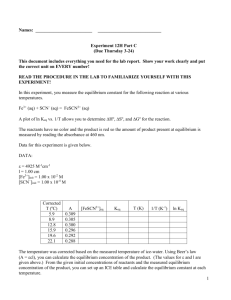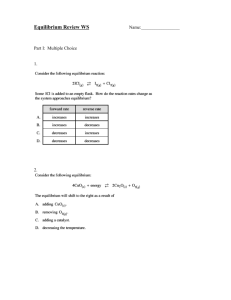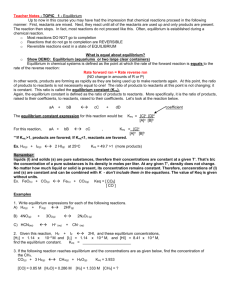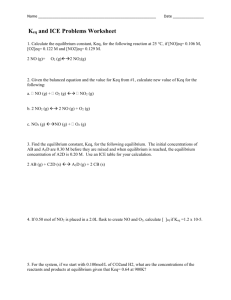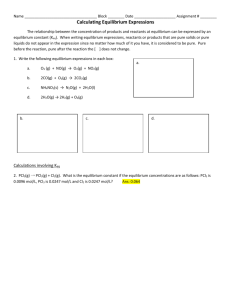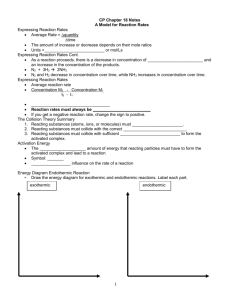Chemistry Keq Calculations: Tutorial Solutions
advertisement
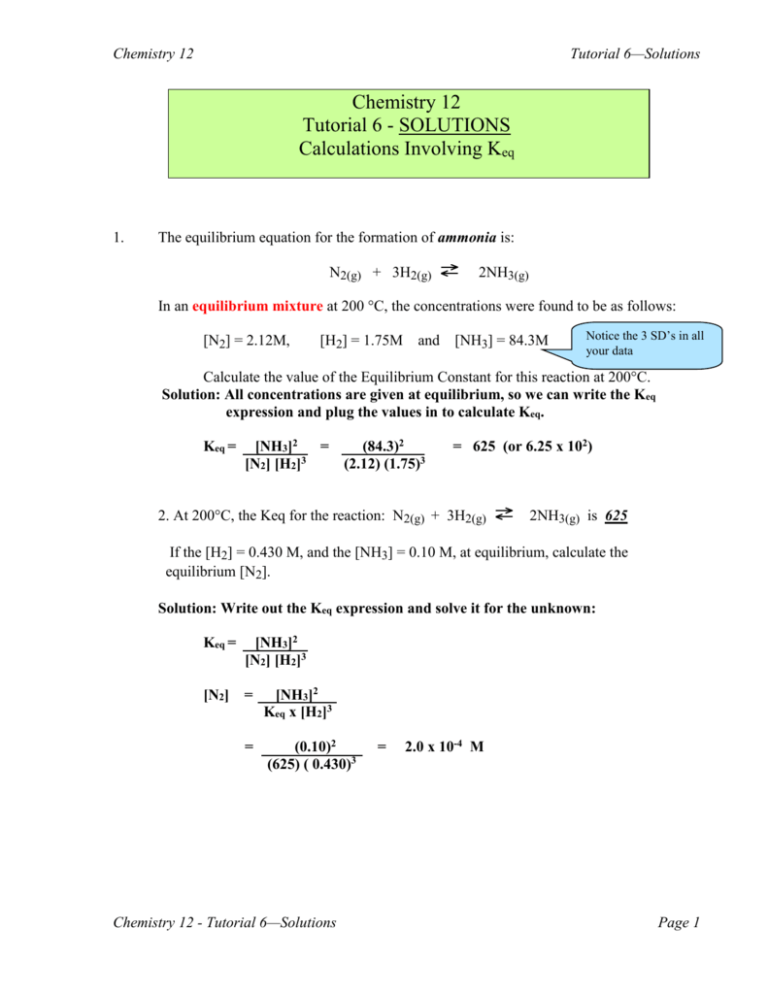
Chemistry 12 Tutorial 6—Solutions Chemistry 12 Tutorial 6 - SOLUTIONS Calculations Involving Keq 1. The equilibrium equation for the formation of ammonia is: N2(g) + 3H2(g) 2NH3(g) In an equilibrium mixture at 200 °C, the concentrations were found to be as follows: [N2] = 2.12M, [H2] = 1.75M and [NH3] = 84.3M Notice the 3 SD’s in all your data Calculate the value of the Equilibrium Constant for this reaction at 200°C. Solution: All concentrations are given at equilibrium, so we can write the Keq expression and plug the values in to calculate Keq. Keq = [NH3]2 = 3 [N2] [H2] (84.3)2 (2.12) (1.75)3 = 625 (or 6.25 x 102) 2. At 200°C, the Keq for the reaction: N2(g) + 3H2(g) 2NH3(g) is 625 If the [H2] = 0.430 M, and the [NH3] = 0.10 M, at equilibrium, calculate the equilibrium [N2]. Solution: Write out the Keq expression and solve it for the unknown: Keq = [NH3]2 [N2] [H2]3 [N2] = [NH3]2 Keq x [H2]3 = (0.10)2 (625) ( 0.430)3 Chemistry 12 - Tutorial 6—Solutions = 2.0 x 10-4 M Page 1 Chemistry 12 3. Tutorial 6—Solutions Consider the following equilibrium system: 2NO(g) + Cl2(g) 2NOCl(g) 0.80 moles of NO and 0.60 moles of Cl2 are placed into a 1.0 L container and allowed to establish equilibrium. At equilibrium [NOCl] = 0.56 M. a) Calculate the equilibrium [NO] b) Calculate the equilibrium [Cl2] c) Determine the value of Keq at this temperature. NOTE: In a 1.0 Litre container, concentration is moles/ 1.0 litre, so concentration is the same as the moles. In other words, if 0.80 moles of NO are placed in a 1.0 L container, the initial concentration of NO = 0.80 M 2NO(g) 0.80 - 0.56 0.24 [I] [C] [E] Keq = [NOCl]2 [NO]2 [Cl]2 = + (0.56)2 (0.24)2 (0.32) Cl2(g) 0.60 - 0.28 0.32 2NOCl(g) 0 + 0.56 0.56 = 17 a). The equilibrium [NO] = 0.24 M b). The equilibrium [Cl2] = 0.32 M c). The value of Keq = 17 Chemistry 12 - Tutorial 6—Solutions Page 2 Chemistry 12 4. Tutorial 6—Solutions Given the equilibrium equation: A + 2B C When 2.0 moles of A and 4.0 moles of B are added to a 10.0 L container, an equilibrium established in which 1.4 moles of C are found. Find the equilibrium concentrations of A, B and C. Solution: The initial concentration of A is 2.0mol = 0.20 M 10.0 L The initial concentration of B is 4.0mol = 0.40 M 10.0 L The equilibrium concentration of C is 1.4mol = 0.14 M 10.0 L [I] [C] [E] A 0.20 -0.14 0.06 + 2B 0.40 -0.28 0.12 C 0 + 0.14 0.14 Subtraction, so answer is to 2 dec. places. C] = 0.14 M Chemistry 12 - Tutorial 6—Solutions Page 3 Chemistry 12 5. Tutorial 6—Solutions The equilibrium equation: PCl5(g) PCl3(g) + Cl2(g) has a Keq = 0.50 at 25°C. If 0.60 moles of PCl3 , 0.45 moles of Cl2 and 0.26 moles of PCl5 are all placed in a 1.0 L container, will the reaction move to the left, right or not at all in order to reach equilibrium? Solution: Keq expression: Keq = [PCl3] [Cl2] [PCl5] Plug in the values for initial concentration to calculate the Trial Keq (Trial Quotient “Q”) Trial Keq = [PCl3] [Cl2] [PCl5] = (0.60) (0.45) = 1.038 = 1.0 (2SD’s) (0.26) Trial Keq (1.0) > Keq (0.50) so the ratio of Products/Reactants is too high. As equilibrium is approached, the reaction will move to the LEFT. ( [PCl5] will increase and the [PCl3] and [Cl2] will decrease.) Chemistry 12 - Tutorial 6—Solutions Page 4 Chemistry 12 6. Tutorial 6—Solutions Consider the reaction: H2(g) + CO2(g) H2O(g) + CO(g) At a certain temperature the Keq for this reaction = 1.50 If the initial concentration of all four species = 0.500 M, calculate the equilibrium concentration of CO2 and CO. Remember to determine which way the reaction has to shift in order to reach equilibrium using a Trial Keq (Sometimes this can be done in your head) Solution: Trial Keq = [H2O] [CO] = (0.500) (0.500) = 1.0 which is < Keq (1.5) [H2] [CO2] (0.500) (0.500) so reaction will move RIGHT. Let “x” = the change (decrease) in the [H2] as the reaction moves to the right. Make an ICE table: H2(g) 0.500 -x 0.500 - x [I] [C] [E] [E] [E] + CO2(g) 0.500 -x 0.500 - x H2O(g) 0.500 +x 0.500 + x + CO(g) 0.500 +x 0.500 + x Plug [E]’s into the Keq Expression: Keq = [H2O] [CO] = [H2] [CO2] (0.500 + x) (0.500 + x) (0.500 - x) (0.500 - x) Keq = (0.500 + x)2 ( 0.500 – x)2 Keq 1.50 = (0.500 + x)2 ( 0.500 – x)2 = (0.500 + x) (0.500 - x) 1.2247 (0.500 - x) = (0.500 + x) (continued on the next page…) Chemistry 12 - Tutorial 6—Solutions Page 5 Chemistry 12 Tutorial 6—Solutions 1.2247 (0.500 - x) = (0.500 + x) 0.61237 - 1.2247 x = 0.500 + x 0.61237 - 0.500 = 1.2247 x + x 0.11237 = 2.2247 x x = 0.11237 2.2247 = 0.05051 M Put the value for “x” (0.05051 M) back into the table and solve for the concentrations: H2(g) + 0.500 -x 0.500 - x 0.500 - 0.05051 0.4495 [I] [C] [E] [E] [E] Answer CO2(g) 0.500 -x 0.500 - x 0.500 - 0.05051 0.4495 H2O(g) + CO(g) 0.500 0.500 +x +x 0.500 + x 0.500 + x 0.500 + 0.05051 0.500 + 0.05051 0.5505 0.5505 Equilibrium [CO] = 0.551 M Equilibrium [CO2] = 0.450 M Answers to Self-Test on Tutorial 6 1. Given the equilibrium: 3A(g) + B(g) 2C(g) If 4.0 moles of A and 2.0 moles of B are added to a 2.0 L container, an equilibrium is established in which the [C] = 0.40 M. a) Calculate the equilibrium [A] and [B] Solution: Initial [A] = 4.0 mol/2.0L = 2.0 M Initial [B] = 2.0 mol/2.0 L = 1.0 M [I] [C] [E] 3A(g) 2.0 - 0.60 1.4 + Equilibrium [A] = 1.4 M B(g) 1.0 - 0.20 0.8 2C(g) 0 + 0.40 0.40 1 dp = 1SD due to subtracting from 1.0 (1 dp) Equilibrium [B] = 0.8 M Chemistry 12 - Tutorial 6—Solutions Page 6 Chemistry 12 Tutorial 6—Solutions b) Calculate the value of Keq at the temperature at which this was carried out. Keq 2. = [C]2 [A]3 [B] = (0.40)2 = 0.073 = 0.07 (to 1 SD) (1.4)3 (0.8) Given the equilibrium equation: A(g) + B(g) C(g) + D(g) The value of Keq for this reaction at 25 °C is 34.6 0.200 moles of A, B, C & D are all added to a 1.0 L container. Calculate the [B] at equilibrium. HINT: The reaction will have to shift to the right in order to reach equilibrium, because Trial Keq (1.0)< Keq (34.6) A(g) 0.200 -x 0.200 - x [I] [C] [E] [E] [E] + B(g) 0.200 -x 0.200 - x C(g) 0.200 +x 0.200 + x + D(g) 0.200 +x 0.200 + x Keq = [C] [D] [A] [B] 34.6 = (0.200 + x)2 (0.200 - x)2 34.6 = (0.200 + x)2 (0.200 - x)2 5.882 = (0.200 + x) (0.200 - x) 5.882 (0.200 - x) = 0.200 + x 1.1764 - 5.882 x = 0.200 + x (add 5.882 x to both sides) 1.1764 = 0.200 + 6.882 x (subtract 0.200 from both sides) 6.882 x = 0.9764 (divide each side by 6.882) Chemistry 12 - Tutorial 6—Solutions Page 7 Chemistry 12 Tutorial 6—Solutions 6.882 x = 0.9764 (divide each side by 6.882) x = 0.9764 6.882 = 0.142 Now we have x = 0.142, we put this into the last two rows of the ICE table: A(g) + B(g) 0.200 0.200 -x -x 0.200 - x 0.200 - x 0.200 – 0.142 0.200 – 0.142 0.058 0.058 [I] [C] [E] [E] [E] C(g) + D(g) 0.200 0.200 +x +x 0.200 + x 0.200 + x 0.200 + 0.142 0.200 + 0.142 0.342 0.342 So Equilibrium [B] = 0.058 M 3. Consider the equation: 2X(g) + 3Y(g) 2Z(g) An equilibrium mixture is analyzed and [X] is 0.030M, [Y] = 0.500M and [Z] = 0.600M 2 SD’s Calculate the value of Keq for this reaction. Everything is at equilibrium already, so there is no ICE table. We just plug [E]’s into the Keq expression: Keq = = [Z]2 [X]2 [Y]3 (0.600)2 (0.030)2 (0.500)3 = 3200 or 3.2 x 102 Chemistry 12 - Tutorial 6—Solutions Page 8 Chemistry 12 4. Tutorial 6—Solutions The Keq for the reaction: A(g) + B(g) 2C(g) is 1.20 A mixture of A, B and C is analyzed and found to contain 3.0M A, 0.40M B and 2.50M C. This reaction will shift which way (left, right or not at all) in order to reach equilibrium? We start by calculating a Trial Keq : Trial Keq = [C]2 [A] [B] = (2.50)2 (3.0) (0.40) = 5.21 Since Trial Keq (5.21) > Keq (1.20), the reaction will move to the LEFT in order to reach equilibrium. As it moves to the left, [A] and [B] will increase and [C] will decrease. This is the end of Tutorial 6 Solutions Chemistry 12 - Tutorial 6—Solutions Page 9


